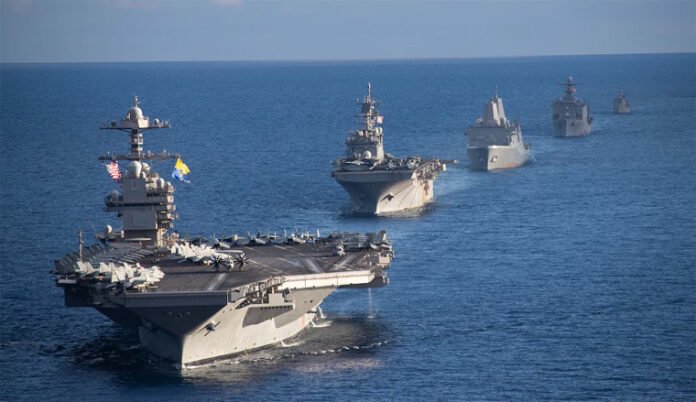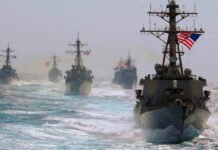The United States has taken a bold step in its Western Hemisphere military posture. On October 24–25, 2025, the Pentagon announced the deployment of the nuclear-powered super-carrier USS Gerald R. Ford and its supporting strike group to Latin America’s waters — particularly the Caribbean off the coast of Venezuela. Reuters+2AP News+2 What began as what Washington calls a “counter-narcotics” operation is being widely interpreted as a major escalation in regional military presence — with far-reaching security, diplomatic and geopolitical implications.
What the Deployment Entails
According to Pentagon spokesperson Sean Parnell, the carrier strike group will “bolster U.S. capacity to detect, monitor and disrupt illicit actors and activities that compromise the safety and prosperity of the United States homeland and our security in the Western Hemisphere.” Reuters+1
Key details:
The USS Gerald R. Ford, which is the newest and most advanced U.S. aircraft carrier, heads for the Caribbean after operations in the Mediterranean. Reuters+1
It joins an existing U.S. naval and air-force footprint in the region that already includes destroyers, F-35 fighter jets, drones and a reported 6,000+ troops. AP News+1
Although the official narrative focuses on combating drug trafficking, analysts and regional governments say the move may prepare for broader operations — possibly against land-based targets in Venezuela. The Guardian+1
Why This Matters
1. Regional Security & Drug Trafficking: The U.S. frames the deployment as part of a crackdown on transnational criminal organisations — particularly those moving drugs through the Caribbean route. The build-up comes after multiple U.S. strikes on alleged drug-trafficking vessels, with at least 40 killed since September. Reuters+1
2. Venezuela & Political Risk: The positioning off Venezuela has triggered alarm in Caracas, where President Nicolás Maduro warned of possible intervention. Critics say the operation bears the hallmarks of a strategy to apply pressure—if not outright regime change. The Times of India+1
3. International Law & Precedent: Deploying a carrier strike group near another sovereign state, combined with previous lethal strikes on vessels, raises legal and diplomatic questions about jurisdiction, sovereignty and the rules of engagement. Wikipedia+1
4. Implications for U.S. Foreign Policy: This reflects a shift in U.S. military engagement in Latin America under the Donald Trump administration, from primarily law-enforcement operations to full-scale military deterrence or intervention posture. The Guardian
Possible Scenarios Ahead
Intensified “Counter-Narco” Operations: The carrier provides a platform for air and sea assets to sustain deeper interdiction missions in the Caribbean and Atlantic maritime routes.
Land-Based Target Options: With F-35 jets and special operations assets in theatre, the U.S. retains the capability to shift from maritime to land operations — e.g., targeting drug labs or cartel infrastructure inside Venezuela. Stars and Stripes
Regional Diplomatic Fallout: Countries in Latin America and the Caribbean may view the deployment as an escalation of U.S. dominance, potentially prompting multilateral condemnation, stronger Russian/Chinese presence, or increased resistance to U.S. basing rights.
Domestic U.S. and Congressional Review: The expansion of overseas military operations will likely draw scrutiny from Congress over cost, legality, mission clarity and escalation risk.
What to Watch
Further Pentagon Statements: Any update on rules of engagement, deployment zones, and timeline will clarify whether this is purely counter-narcotics or a broader deterrence posture.
Venezuelan / Colombian Reaction: Watch for military mobilisations, public statements from Maduro and Colombian President Gustavo Petro, and potential diplomatic protests. Reuters
Media & NGO Reports on Vessel Strikes: Reports of casualties or expanded targeting may trigger international investigations or human-rights scrutiny.
Commercial Shipping / Insurance Impacts: A heightened U.S. naval footprint may affect shipping routes, insurance premiums in the Caribbean and Caribbean states’ maritime economies.
Budget and Oversight in U.S.: How the Administration justifies the cost and mission may determine whether the deployment is scaled back or formalised into longer-term presence.
Quick FAQ
Is this an invasion? No publicly announced land invasion exists currently. The U.S. says the mission is maritime, but analysts caution the assets onboard imply wider options.
Does this affect India / Asia? Indirectly — shifts in global naval presence and U.S. force posture can change power-balance dynamics globally, including India’s maritime interests.
How can civilians stay informed? Follow official Pentagon releases, U.S. Southern Command updates, and credible regional sources such as Al Jazeera, Reuters and AP.
Conclusion
The deployment of the USS Gerald R. Ford strike group to the Caribbean signifies a turning point in U.S. military posture in Latin America. While counter-narcotics remains the official rationale, the scale and capability hint at much broader strategic intent. With regional tensions high, the stage is set for an evolving theatre of maritime power, diplomacy and geopolitical risk. For your blog readers: this story is not just about one warship—it is about shifting global strategy, regional sovereignty and the balance of power in the Americas.
















